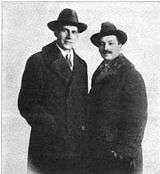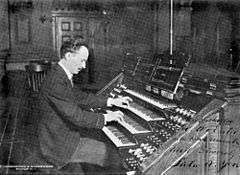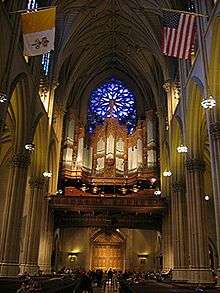Pietro Yon
| Pietro A. Yon | |
|---|---|
|
Pietro Yon, 1918 | |
| Born |
August 8, 1886 Settimo Vittone, (Piedmont, Italy) |
| Died |
November 22, 1943 (aged 57) Huntington, New York |
| Nationality | Italy and USA |
| Known for | organ virtuoso and composer |
 |
|
| Problems playing this file? See media help. | |
Pietro Alessandro Yon[1] (August 8, 1886 – November 22, 1943) was an Italian-born organist and composer who made his career in the United States.
Early life
Yon was born in Settimo Vittone, (Piedmont, Italy), and studied at the conservatories of both Milan and Turin, also attending the Accademia di Santa Cecilia in Rome; among his teachers in Milan was Polibio Fumagalli. He served for a time as an organist at the Vatican and at the Royal Church in Rome.
Relocation to America

In the spring of 1907, Father John B. Young, pastor of St. Francis Xavier Church in Manhattan, was in Rome on Vatican business and additionally to seek out a replacement for his organist Gaston Dethier, who was leaving to pursue a concert career. Upon hearing Yon play, Father Young was sufficiently impressed to offer him a three-year contract. Thus Yon at age 21 came to the United States, where from 1907 until 1926 he was the organist of St. Francis Xavier Church. He joined his brother S. Constantino Yon, who had preceded him and held a similar position at St. Vincent Ferrer Church.

In 1914, Pietro and Constantino Yon opened the Yon Music Studios[2] in Carnegie Hall, a conservatory for aspiring liturgical musicians utilizing a small number of instructors whose work he respected. Pietro would head the organ department while Constantino was in charge of the vocalists.
In 1919, when Yon was married to Francesca Pesagno, the organist for the occasion was one of Yon's newest friends, the Belgian-American virtuoso Charles M. Courboin who had been chosen to rededicate the Wanamaker Organ in Philadelphia, now enlarged to 17,000 pipes and still the largest operational organ in the world. In 1920, Yon would share the stage at Wanamaker's with Courboin, Leopold Stokowski, and the Philadelphia Orchestra in one of the gala organ recitals performed at the store through the 1920s.[1]
Yon became an American citizen in 1921.[3]
On January 1, 1922 Yon was appointed 'Titular Organist' of the Vatican, a singular and unprecedented honor. The appointment put pressure on New York church authorities to promote Yon to a more-prestigious position.
St. Patrick Cathedral

In 1926, he became the assistant organist of St. Patrick's Cathedral, New York. Shortly after his arrival, church authorities began to discuss the possibility of replacing their existing Jardine and Odell organs, which were installed when the Cathedral was built. The Cathedral's 1929 Jubilee year was near and funding had become available for improvements.
By 1927, it was announced that the Kilgen firm of St. Louis, Missouri had been selected to build the chancel, gallery and echo (triforium) organs, with Courboin as tonal designer. The resulting instrument was then and remains now the magnum opus of the Kilgen firm and one of the finest organs in the world.
Also in 1927 Yon was approached by Carnegie Hall to assist in the replacement of its outmoded Hillgreen, Lane organ with a 4-manual, 59-rank instrument, also by Kilgen with Courboin as tonal director. And a 3-manual Kilgen instrument was to be built for the Yon Music Studios.
Work proceeded rapidly on the Cathedral chancel organ, and by January 1928 the instrument had been installed (still without the elaborate organ case). Associate organist Yon presided over the dedication recital on January 30, 1928. The organ console was relocated to the sanctuary for the performance, which was a major social and musical event attended by 5,000 ticketholders.[1]
On May 1, 1928, Yon was promoted to music director replacing James C. Ungerer, who had been at the Cathedral for 36 years.
In 1933, when the position of Associate Organist at the Cathedral became vacant, Yon chose as a replacement Edward J. Rivetti, one of his own students. Though Rivetti never actually became principal organist he served as assistant under both Yon and successor Courboin until 1970.
In the spring of 1938, both Pietro and Constantino Yon were appointed as Knights of St. Sylvester by Cardinal Patrick Hayes, who would die within a month of the appointment. Pietro also toured the country giving recitals.
Composer
Yon was also a composer, most famous for his Humoresque "L'organo primitivo"- Toccatina for Flute,[4] for organ, and his Christmas piece Gesù bambino.[5] He also wrote many works for organ, piano, and orchestra, including a Concerto Gregoriano for organ and orchestra (inspired by his experiences with the Wanamaker Organ) (with a companion version for organ and piano),[6] Speranza (Hope) - Solo for Diapason, Concert Study #1[7] and #2, American Rhapsody [8] and a concerto for oboe.
Teacher
Yon's pupils included Cole Porter, Georges-Émile Tanguay, Powell Weaver (Kansas City), Edgar Bowman (Pittsburgh), Robert Elmore (Philadelphia),[9] Mary Downey (New York),[10] Henry Seibert (New York),[11] Eugene Phillips (Grand Rapids), Tracy Y. Cannon (Salt Lake City, organist at the Mormon Tabernacle), Helen Knox Ferguson (Dallas), Helen Townsend (Buffalo), Franklin Coates (N.Y.City), Dorothy Mulroney (organist at the Municipal Auditorium Springfield, Mass.), Wilbur Chenowetch (Professor of organ and organist of the Plymouth Church, Lincoln, Neb.), Alan Bucher (Peekskill N.Y.), Edward Rivetti, assistant organist at St. Patrick's Cathedral, N.Y., Radie Britain (Dallas) and Yon's godson Norman Dello Joio.
Illness and death
On April 9, 1943, Yon suffered a massive stroke that paralyzed his entire right side. As a result, he was unable to fulfill his obligations at St. Patrick's Cathedral and was temporarily replaced by long-time assistant Edward Rivetti.
At first, Yon was sent to Columbia Hospital. Eventually, it was decided to move him to a friend's house in Long Island, where it was thought that he would recover better. In the meantime, the Cathedral held his position open and refused application from organists who wanted to replace him.
In time, it became obvious that Yon would take a long time to recover if at all. Courboin was available as a substitute "for the duration of the illness of Pietro Yon". He was heavily engaged in a recital and teaching career, in addition to consultation on many new organs and performing radio broadcasts on WOR. On October 2, 1943, Courboin was appointed interim organist while Yon was ill.
Yon died in Huntington, New York on November 22, 1943, the feast of St Cecilia. His funeral, which took place on the 25th, was attended by 1,300 including Toscanini. Courboin conducted the choir in Yon's own Mass of Requiem.
Notes
- 1 2 3 Basile, Salvatore (2010). Fifth Avenue Famous: The Extraordinary Story of Music at St. Patrick's Cathedral. New York: Fordham University Press. ISBN 978-0-8232-3187-4.
- ↑ https://books.google.com/books?id=vStEAQAAIAAJ&pg=PA52 Advertisement for Yon Music Studios
- ↑ "Pietro Yon Dead; a Noted Organist", New York Times (Nov. 23, 1943), p. 25.
- ↑ Dianne Bish plays Yon's Toccatina for Flutes on the Cadet Chapel Organ, West Point NY on YouTube
- ↑ Mormon Tabernacle Choir sing Gesu Bambino on YouTube
- ↑ Dianne Bish and Simon Preston perform the final movement of Yon's Concerto Gregorian on two organs on YouTube
- ↑ Concert Study #1 on YouTube
- ↑ American Rhapsody on YouTube
- ↑ http://www.robertelmore.org/ website dedicated to Yon student Robert Elmore
- ↑ http://www.staugustinedenver.org/pdfs/Mary_Downey.pdf article on Yon student Mary E. Downey
- ↑ https://news.google.com/newspapers?nid=1955&dat=19491026&id=zrwhAAAAIBAJ&sjid=s5wFAAAAIBAJ&pg=4346,2920564 brief article and photo of Dr. Seibert, pupil of Pietro Yon
References
- David Ewen, Encyclopedia of Concert Music. New York; Hill and Wang, 1959.
External links
- Free scores by Pietro Yon in the Choral Public Domain Library (ChoralWiki)
- Free scores by Pietro Yon at the International Music Score Library Project
- Corrado Cavalli plays the "Finale del Concerto Gregoriano" on the great organ in Messina on YouTube.
- Works by or about Pietro Yon at Internet Archive
| Preceded by Jacques C. Ungerer |
Organist and Director of Music, St Patrick's Cathedral 1927-1943 |
Succeeded by Charles M. Courboin |
